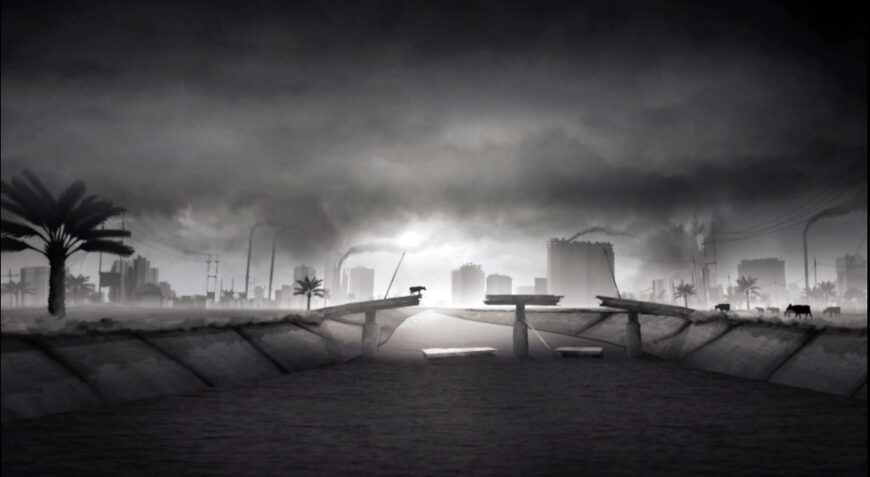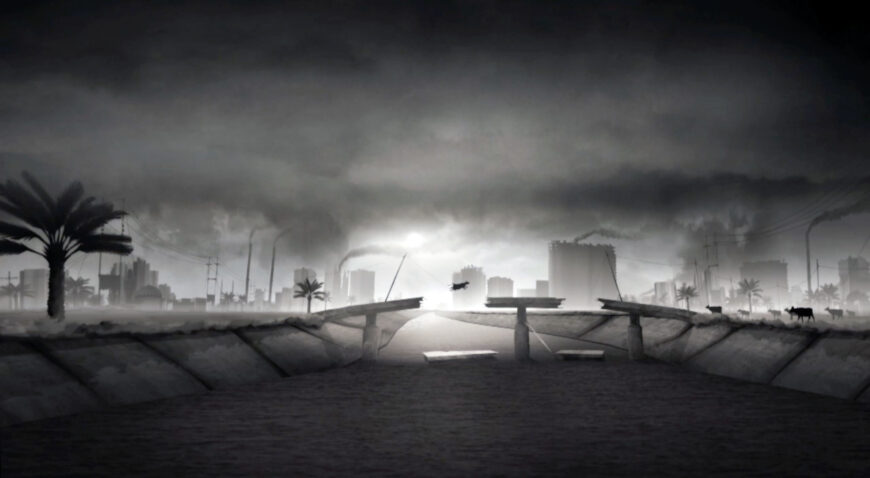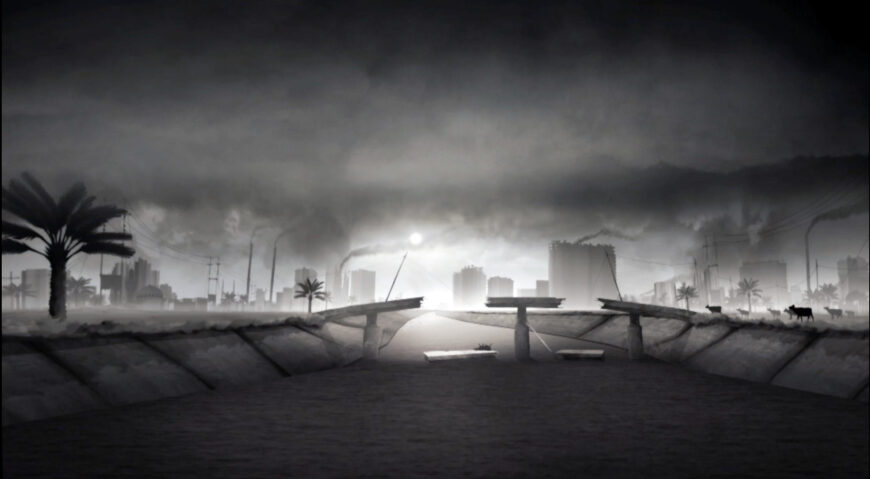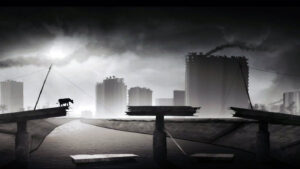The video captures a black-and-white cityscape in which a singular cow is stranded on the edge of a bridge broken in three parts. Across a body of water, the marooned cow calls out to a small herd of cows on the other side, who answer with wails of their own. With the exception of the cows’ desperate cries, the landscape is shrouded in stillness and silence. The urban infrastructure is desolate and the only signs of nature—the palm trees, the river, and clouds—move only ever so slightly, mere hints of life.
As the tempo of the accompanying instrumental music builds, the short video captures the cow’s futile attempt to reunite with her herd across the river. Determined, she turns back, makes a running start, and attempts the leap across. For a moment, the cow clings desperately to the edge of the broken bridge, suspended between survival and death, until she falls to the river below.
In this nearly 3-minute video work, contemporary Iraqi artist Adel Abidin uses computer generated imagery to narrate a poignant story of a stranded cow, and ultimately the unattainable goal of reconciliation with her herd. Set in Baghdad, the black-and-white animation captures a day during the first Gulf War in 1991 when the United States military bombed the Iraqi capital, destroying the Al-Jumhuriya bridge that unites the two banks of the Tigris River in the center of the city. In Abidin’s video, smoke rises from the burning city as the cows are estranged amidst a dark industrial setting. Reflecting on the need for community in the aftermath of war and destruction, Memorial is part of a larger body of work in which Abidin considers the stories and experiences of generations of Iraqis who have lived their lives through a state of warfare and U.S. military occupation since 1990.
Adel Abidin, Memorial, 2009, video installation, 2:56 minute loop (from La Gaîté Lyrique on Vimeo)
U.S. military presence in Iraq
Two years after the Iran-Iraq War ended (1980–88), the citizens of Iraq found themselves living under siege once again. On August 2, 1990, then Iraqi President Saddam Hussein invaded the neighboring State of Kuwait, with the supposed aim of acquiring the nation’s oil reserves. In response, a 35-country military coalition launched an armed campaign in January, with a U.S.-led air campaign. Known as Operation Desert Storm, the air strike attacked Iraq’s air defenses, communication networks, government buildings, weapon plants, oil refineries, and roads and bridges, including Al-Jumhuriya Bridge (known in English as The Republic Bridge).
At the time, Abdin was 17 years old and recalls riding his bicycle to this landmark bridge, which had been destroyed on the third day of the American bombardment. There, he encountered what he described as a surreal scene of a cow stranded in the bombed out urban landscape. Imagining her future resulted in Memorial.

Adel Abidin, Abidin Travels, mixed media and video/sound installation, 2003, video #1: 2 minute loop, video #2: 4:33 minute loop, round light box 90 cm diameter, title light box, 60 cm x 180 cm, brochures, posters, computer, printer (warning: the video includes violent images; watch a clip excerpt here)
Representing war
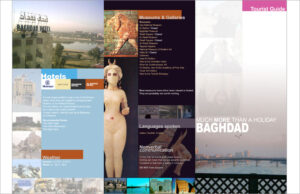
Adel Abidin, Abidin Travels, mixed media and video/sound installation, 2003, video #1: 2 minute loop, video #2: 4:33 minute loop, round light box 90 cm diameter, title light box, 60 cm x 180 cm, brochures, posters, computer, printer (warning: the video includes violent images; watch a video clip here)
Operation Desert Storm launched three decades of U.S. military presence in Iraq and is the subject of much of Abidin’s work. He often utilizes humor and sarcasm to address these volatile topics. For the 2007 Nordic Pavilion at the Venice Biennale, Abidin created the video, Abidin Travels, in which a fictional travel agency promotes tourism to Baghdad. As the narrator describes in an enthusiastic voice the Iraqi capital’s cafe-filled streets, rich architectural history, and the art-filled museums, the video shows clips from post-occupied Baghdad: US military patrolling streets, the aftermath of car bombs, destroyed infrastructure, and the stockpiling of weapons. The discrepancy between the narration and the images highlights the radical difference between Baghdad’s historical role as a cultural capital of the Arab world and its contemporary state.
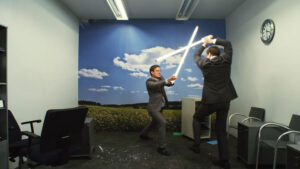
Adel Abidin, Consumption of War, 2011, video/sound installation, 3:20 minute loop (watch a video clip here)
Ironic humor is also at the heart of Abidin’s later video, Consumption of War, featured in the Iraqi Pavilion at 2011 Venice Biennale. This piece captures two middle-aged, white males, dressed in similar suits with wire-rimmed glasses, fighting with Star Wars-like light swords in a banal, unremarkable office. In an elaborate choreography, the two jump onto file cabinets and office furniture, dodging each other’s swords throughout the confined space. As the men narrate the battle through the swooshing sound effects of fighting, the video suggests both a violent intensity and youthful game. Whereas the figures’ facial expressions and gestures suggest a high stakes battle, the banal office space and clean suits offer a sharp commentary on the ease and game-like nature with which the privileged wage war and we, as viewers, uncritically consume violence daily through the media.

Adel Abidin, Common Vocabulary, 2006, one channel video installation, 4:00 minute loop, drawings: 8 different cards, Size: 15 x 15 cm (watch a video clip here)
Other videos in Abdin’s body of work approach the protracted conflict in Iraq following the first Gulf war in stark terms. In the 2006 video Common Vocabulary, school-age children repeat Arabic words related to war: genocide, mass grave, Saddam, court house, judge. As the unseen adult male announcing the words corrects the pronunciation of the young students repeating the terms, the viewer becomes increasingly aware of the child’s differing familiarity with certain words such as forbidden and courthouse and those terms whose relevance is specific to post-occupied Baghdad, such as genocide and mass grave.
Alongside Memorial, these video works by Abidin underscore the brutal effects of war on civilians, from seemingly mundane shifts in language that trace a history of protracted violence to the detached, game-like approach towards war among the privileged. Amid the destruction of infrastructure and architectural heritage, represented in Al-Jumhuriya Bridge in Memorial, we are left with the desperation of a stranded, displaced cow whose fatal leap across the bridge may signal one of the greatest sacrifices of war—that of community.
Artists during times of conflict
Artists have long represented war in a variety of ways. Nineteenth-century painter Antoine Gros memorialized Napoleon Bonaparte’s campaign in Egypt and Syria (1798–1801), militarily a failure but a propagandistic success in Gros’s canvases. A century later, in 1909, the Italian Futurists penned a manifesto glorifying war as a tabula rasa (clean slate) for cultural regeneration. The brutality of World War I (1914–18) would later lead Dada artists throughout Europe to embrace experimentalism and irrationalism as a means through which to interrogate the presumed rationality and the failed promises of capitalism, technology, and nationalism. Like Abidin, Dada artists embraced humor and satire to shock viewers out of their complacency and acceptance of values that had led to unprecedented loss of human life during World War I.
Abidin’s art is part of a growing body of work by contemporary artists such as Walid Raad, Wafaa Bilal, and Teresa Margolles who use a variety of media—sound and video installation, sculpture, photography, and digital imagery—to speak to the experience of violence and its traumatic aftermath. Many of these artists live and work in the diaspora precisely because of the condition of war in their home country. After graduating from the renowned Baghdad Academy of Fine Arts in 2000, Abidin continued his studies in Helsinki, since living between Helsinki and Amman, Jordan. Abidin’s representation of war also examines the physical and psychological toll caused by distance and the tension created by conflict and comfort as well cultural alienation.
Although rooted in the specific context of contemporary Iraq, Abidin’s works ask us to think more broadly about conflict in general. In the short video Memorial, we are asked to consider how war radically transforms the history of a place for its inhabitants. In the aftermath of a military strike, a young man bicycles to his favorite bridge. The once historic landmark and familiar cityscape is now a post-apocalyptic site of destruction. The once blue sky now filled with ominous clouds, blackened by oil fields set ablaze. Wondering how a cow ended up in the urban landscape of Baghdad, separated from her herd, Abidin would later imagine her eventual fate from the safety of Helsinki, far removed from the continuing state of war in Baghdad.
Additional resources
Adel Abidin, exhibition catalog (Amman: Darat al-Funun-The Khalid Shoman Foundation, 2015).

